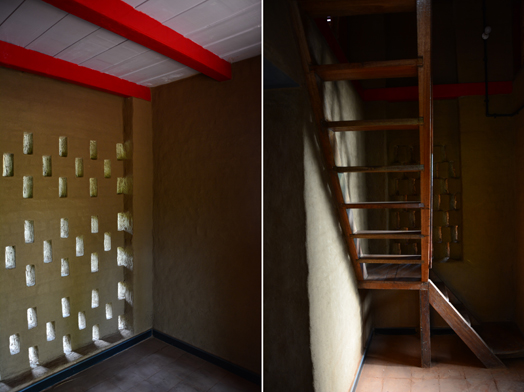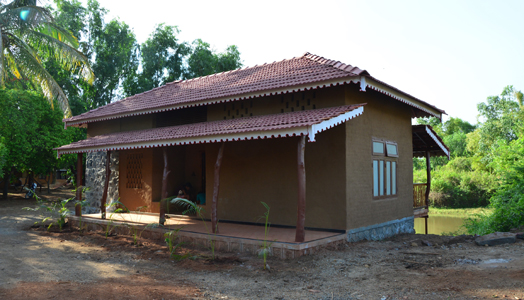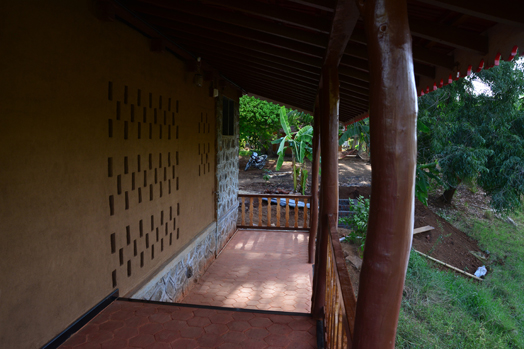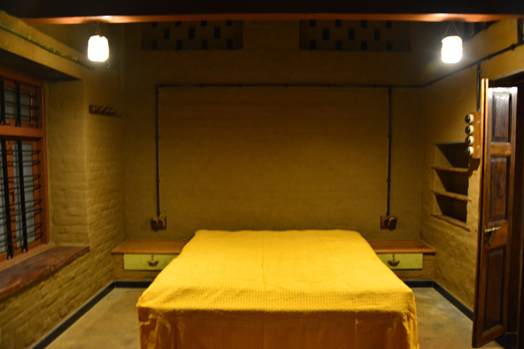By Anuradha K R
Photography: Courtesy
PYHT
An agro-tourism centre in Neral, Maharashtra, promises a bona fide experience of traditional, rural house brimming with feel-good eco-factors. The project serves to raise awareness, interest and expertise levels in traditional architecture…
A
labour of love of bio-architects ‘PutYourHandsTogether’ (PYHT), Adobe Cottage
in Saguna Baug, is an initiative to add more eco-friendly cottages to their
kitty. PYHT is an organization, co-founded by a group of friends with a common
passion to pursue architecture with naturally and locally available materials. Studying
the architectural fabric of nearby villages, PYHT came up with a design that
finds resonance with the climate, context and people.
The
name spills the beans and Adobe Cottage has unburnt bricks/sun-dried adobes as
its building blocks. The most impressive fact about them is that these high-strength
bricks are made without the expense of any fuel. In line with their
architectural philosophy, the ‘bio-architects’ have sourced most of the
building materials from within a radius of 5-7 kms of the site.
A
850 sqft house built on basalt and cement mortar foundation with three bays –
living area, wet area and bed room – Adobe Cottage stands overlooking a pond.
Inspired by local design preferences, the cottage also houses a wooden
mezzanine. Used as a storage space in traditional households, mezzanine serves
to shield the occupants from excessive heat.
 |
| . |
Imbuing
the design with climate-sensitivity, stone wall has been preferred over mud
wall on the western side, which receives maximum rains during monsoons; and it
isn’t coincidental that the wet area of the house is placed there. While all
walls of the house are 14” thick, the eastern wall stands 4” thicker than the
rest. Its ‘breathing’ walls are mud plastered with coatings of jaggery and
linseed oil to keep termites at bay and to enhance waterproofing.
Minimal
use of industrial raw materials, wooden roof under-structure, perforated brickwork
in pockets, reused Mangalore tiles and reused timber for doors and windows stand
testimony to the designers’ commitment to ‘Reduce-Reuse-Recycle’ mantra.
A
cottage, firmly rooted in simplicity and sustainability makes one appreciate
the green ways of life, fondly fostered by masses not so long ago.








Sooner or later, one has to return back to his roots, the nature, for survival. artificial respiration cant be the permanent solution for survival. Living being, product of five basic and natural elements, can find survival with in the lap of the same, of which it is composed of. A sustainable living space has to breathe, see, smell, hear and taste the nature, similar to its occupants/users for long, happy and healthy living.
ReplyDeleteIt is not difficult if we keep doing sustainable development in terms of basic amenities, agricilture, banking, industries, education etc across cities/districts/villages instead of big cities infrastructure development only. We need to create such environment for better tomorrow…hope its happening
ReplyDeleteIt has been happening Mr. Garg since decades and in big cities too. Bangalore is known for its use of mud bricks, cost effective housing, rainwater harvesting and gated communities. There are several isolated examples in other cities too. It is the metropoles that cannot really adapt easily to such measures due to paucity of space and burgeoning population.
ReplyDeleteWhile sustainable design is being practised, it is being done in pockets. This has to go organic.
The above discussion is in response to a discussion thread started on LinkedIn that asks: "Is it becoming more and more difficult for us to remain rooted to basics, as we’re progressing, as a society? Is cutting down on frills, a near impossibility?" Share your views with us.
ReplyDeletekudos
ReplyDeleteOrganic development integrates technology with Mind and the Sense of Space. Especially in the sub continent and other cultures that have evolved ove r thousands of years. The habits are nurtured with peculiar and an ethos that is not easily comprehended by western modern thoughts. Iraq Iran India Beijing and other older civil societies have a continuum of yesterday today tomorrow. There is a deep sense. Of order in their chaos. But difficult to comprehend for the techies. Life is one big mystery. Live it.
ReplyDeleteThe world never seemed so complicated and the challenges facing us Architects never so overwhelming. Today we keep asking for better and sustainable ways for solving design problems. We have long known vernacular architecture as the built forms which evolved organically over time through the skillful craftsmanship of the locals. Probably it's high time we understand what it has evolved into, in today's context and whether a global collaborative design approach integrated with the vernacular sustainability can be our answer.
ReplyDeleteA storage space in traditional households, mezzanine serves to shield the occupants from excessive heat. sustainable tourism
ReplyDelete